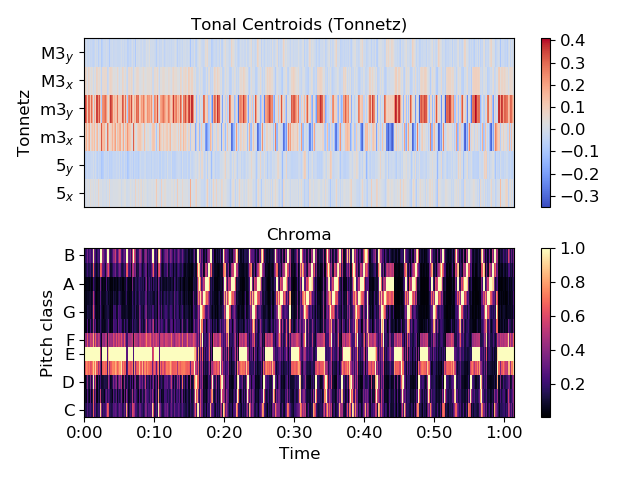librosa.feature.tonnetz¶
-
librosa.feature.tonnetz(y=None, sr=22050, chroma=None)[source]¶ Computes the tonal centroid features (tonnetz), following the method of [1].
[1] Harte, C., Sandler, M., & Gasser, M. (2006). “Detecting Harmonic Change in Musical Audio.” In Proceedings of the 1st ACM Workshop on Audio and Music Computing Multimedia (pp. 21-26). Santa Barbara, CA, USA: ACM Press. doi:10.1145/1178723.1178727. Parameters: - y : np.ndarray [shape=(n,)] or None
Audio time series.
- sr : number > 0 [scalar]
sampling rate of y
- chroma : np.ndarray [shape=(n_chroma, t)] or None
Normalized energy for each chroma bin at each frame.
If None, a cqt chromagram is performed.
Returns: - tonnetz : np.ndarray [shape(6, t)]
Tonal centroid features for each frame.
- Tonnetz dimensions:
- 0: Fifth x-axis
- 1: Fifth y-axis
- 2: Minor x-axis
- 3: Minor y-axis
- 4: Major x-axis
- 5: Major y-axis
See also
chroma_cqt- Compute a chromagram from a constant-Q transform.
chroma_stft- Compute a chromagram from an STFT spectrogram or waveform.
Examples
Compute tonnetz features from the harmonic component of a song
>>> y, sr = librosa.load(librosa.util.example_audio_file()) >>> y = librosa.effects.harmonic(y) >>> tonnetz = librosa.feature.tonnetz(y=y, sr=sr) >>> tonnetz array([[-0.073, -0.053, ..., -0.054, -0.073], [ 0.001, 0.001, ..., -0.054, -0.062], ..., [ 0.039, 0.034, ..., 0.044, 0.064], [ 0.005, 0.002, ..., 0.011, 0.017]])
Compare the tonnetz features to
chroma_cqt>>> import matplotlib.pyplot as plt >>> plt.subplot(2, 1, 1) >>> librosa.display.specshow(tonnetz, y_axis='tonnetz') >>> plt.colorbar() >>> plt.title('Tonal Centroids (Tonnetz)') >>> plt.subplot(2, 1, 2) >>> librosa.display.specshow(librosa.feature.chroma_cqt(y, sr=sr), ... y_axis='chroma', x_axis='time') >>> plt.colorbar() >>> plt.title('Chroma') >>> plt.tight_layout()
